Greece
 From Nwe
From Nwe | Ελληνική Δημοκρατία Ellīnikī́ Dīmokratía
Hellenic Republic
|
||||||
|---|---|---|---|---|---|---|
|
||||||
| Motto: Ελευθερία ή θάνατος Eleftheria i thanatos (transliteration) "Freedom or Death" |
||||||
| Anthem: Ύμνος εις την Ελευθερίαν (Ímnos is tin Eleftherían) Hymn to Liberty |
||||||
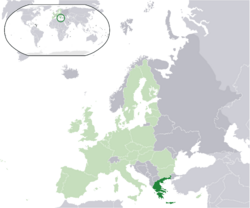
Location of Greece (dark green)
– on the European continent (light green dark grey) – in the European Union (light green) |
||||||
| Capital (and largest city) |
Athens 38°00′N 23°43′E |
|||||
| Official languages | Greek | |||||
| Demonym | Greek | |||||
| Government | Parliamentary republic | |||||
| - | President | Katerina Sakellaropoulou | ||||
| - | Prime Minister | Kyriakos Mitsotakis | ||||
| - | Speaker of the Parliament | Konstantinos Tasoulas | ||||
| Modern statehood | ||||||
| - | Independence from the Ottoman Empire | 25 March 1821 |
||||
| - | Recognized | 3 February 1830, in the London Protocol | ||||
| - | Current constitution | 11 June 1975, "Third Hellenic Republic" | ||||
| EU accession | January 1 1981 | |||||
| Area | ||||||
| - | Total | 131,990 km² (96th) 50,944 sq mi |
||||
| - | Water (%) | 0.8669 | ||||
| Population | ||||||
| - | 2017 estimate | 10,768,477 | ||||
| - | 2011 census | 10,816,286[1] (80th) | ||||
| - | Density | 82/km² (125th) 212/sq mi |
||||
| GDP (PPP) | 2020 estimate | |||||
| - | Total | |||||
| - | Per capita | |||||
| GDP (nominal) | 2020 estimate | |||||
| - | Total | |||||
| - | Per capita | |||||
| Gini (2017) | 34.4[3] (60th) | |||||
| Currency | Euro (€)1 (EUR) |
|||||
| Time zone | EET (UTC+2) | |||||
| - | Summer (DST) | EEST (UTC+3) | ||||
| Internet TLD | .gr3 | |||||
| Calling code | +30 | |||||
| 1 | Prior to 2001: Greek Drachma. | |||||
| 2 | UNU/Wider World Income Inequality Database. | |||||
| 3 | The .eu domain is also used, as it is shared with other European Union member states. | |||||
Greece (Greek: Ελλάδα [eˈlaða] or Ελλάς [eˈlas]), officially the Hellenic Republic (Greek: Ελληνική Δημοκρατία [eliniˈkʲi ðimokraˈtia]), is a country in Southeastern Europe, situated on the southern end of the Balkan Peninsula.
Modern Greece, a developed country and a member of the European Union since 1981, lies at the juncture of Europe, Asia, and Africa. It is heir to the heritages of classical Greece, the Byzantine Empire, and nearly four centuries of Ottoman rule.
Regarded as the cradle of western civilization and the birthplace of democracy, the Olympic Games, western literature, political science, major scientific principles and drama including both tragedy and comedy, Greece has a particularly long and eventful history and a cultural heritage considerably influential in Northern Africa and the Middle East, and fundamentally formative for the culture of Europe and what may be called the West.
Geography
Greece borders Albania, the former Yugoslav Republic of Macedonia and Bulgaria to the north, and Turkey to the east. The Aegean Sea lies to the east and south of mainland Greece, while the Ionian Sea lies to the west. Both parts of the Eastern Mediterranean basin feature a vast number of islands.
With a land area of 50,944 square miles (131,990 square kilometers), Greece is slightly smaller than the state of Alabama in the United States.
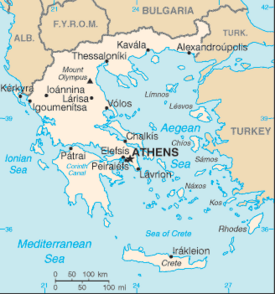
Greece consists of a mountainous and craggy mainland jutting out into the sea at the southern end of the Balkans, the Peloponnesus peninsula (separated from the mainland by the canal of the Isthmus of Corinth), and numerous islands (around 2000), including Crete, Euboea, Lesbos, Chios, the Dodecanese and the Cycladic groups of the Aegean Sea as well as the Ionian Sea islands.
Four-fifths of Greece consist of mountains or hills, making the country one of the most mountainous in Europe. Western Greece contains a number of lakes and wetlands and it is dominated by the Pindus mountain range, which has a maximum elevation of 8648 feet (2636 meters) and it is essentially a prolongation of the Dinaric Alps.
The range continues through the western Peloponnese, crosses the islands of Kythera and Antikythera and find its way into southwestern Aegean, in the island of Crete where it eventually ends. (the islands of the Aegean are peaks of underwater mountains that once constituted an extension of the mainland). Pindus is characterized by its high, steep peaks, often dissected by numerous canyons and a variety of other karstic landscapes. Most notably, the impressive Meteora formation consisting of high, steep boulders provides a breathtaking experience for the hundreds of thousands of tourists who visit the area each year. Special lifts transfer visitors to the scenic monasteries that lie on top of those rocks.


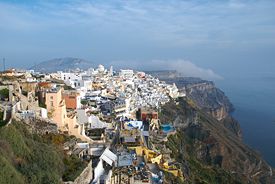
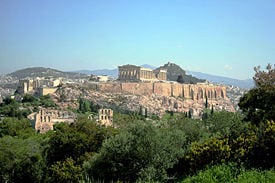
Mount Olympus is the highest mountain in the country, located in the southwestern Pieria prefecture, near Thessaloniki. Mytikas in the Olympus range has a height of 9573 feet (2918 meters). Once considered the throne of the Gods, it is today extremely popular among hikers and climbers who deem its height a challenge.
Expansive plains are primarily located in the prefectures of Thessaly, Central Macedonia and Thrace. They constitute key economic regions as they are among the few arable places in the country. Volos and Larissa are the two largest cities of Thessaly.
Greece's climate is divided into three classes:
- A Mediterranean climate features mild, wet winters and hot, dry summers. Temperatures rarely reach extremes, although snowfalls do occur occasionally even in Athens, Cyclades or Crete during the winter.
- An alpine climate is found primarily in Western Greece (Epirus, Central Greece, Thessaly, Western Macedonia as well as central parts of the Peloponnese like Achaea, Arkadia and parts of Lakonia where the Alpine range pass by).
- A temperate climate is found in Central and Eastern Macedonia as well as in Thrace at places like Komotini, Xanthi and northern Evros; with cold, damp winters and hot, dry summers.
The southern suburbs of Athens are in the Mediterranean zone, while northern suburbs have a temperate climate. The average January (winter) temperature in Athens is 50°F (10°C). July (summer) sea-level temperature approaches 80°F (27°C), although heat waves can push the temperature up over 100°F (38°C).
Most rivers in Greece are short, unsuitable for navigation, and of limited use for irrigation. The main rivers are the Vardar, Struma, and Néstos, which cross Greek Macedonia and Thrace to enter the northern Aegean. Also in the northeast are the east-flowing Aliákmon and Piniós (Peneus), and in the Peloponnese, is the Evrótas.
Fifty percent of Greece is covered by forests with a rich varied vegetation which spans from Alpine coniferous to the Mediterranean type vegetation. Seals, sea turtles and other rare marine life live in the seas around Greece, while Greece's forests provide home to brown bears and lynx and to wolves, roe deer, wild goat, foxes and boars, amongst others.
Natural resources include lignite, petroleum, iron ore, bauxite, lead, zinc, nickel, magnesite, marble, salt, and hydropower potential.
Severe earthquakes are the main natural hazard, while air and water pollution are the main environmental issues. Air pollution remains to some degree an issue for Athens, particularly on the hottest summer days. Nevertheless, widespread measures taken by the authorities throughout the 1990s have dramatically improved air quality.
Athens is the capital and largest city in Greece, and as one of the world's oldest cities, its recorded history spans at least 3000 years. Today the Greek capital, Europe's eighth largest conurbation, is rapidly becoming a leading business center in the European Union. A bustling and cosmopolitan metropolis with an urban population of 3.3 million and total population of about 3.8 million, Athens is central to economic, financial, industrial, political and cultural life in Greece. Thessaloniki, Patras, Heraklion, Volos and Larissa are some of the country's other major cities.
History

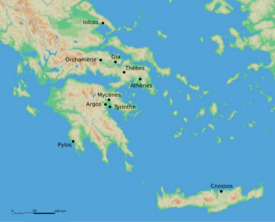
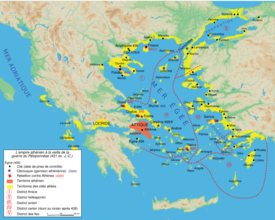
Primitive Mediterranean people, close to the races of north Africa, inhabited the southern Aegean area as far back as the Neolithic Age, before 4000 B.C.E. The Greeks are believed to have migrated southward into the Balkan peninsula in several waves beginning in the late third millennium B.C.E., the last being the Dorian invasion.
The Minoans
One of the earliest civilizations to appear around Greece was the Minoan civilization in Crete, which lasted approximately from 2700 (Early Minoan) B.C.E. to 1450 B.C.E., and the Early Helladic period on the Greek mainland from ca. 2800 B.C.E. to 2100 B.C.E. They were primarily a mercantile people engaged in overseas trade, taking advantage of their land's rich natural resources, mostly timber, which they exported. The Minoans had a developed culture and used a script called Linear A. They were eventually invaded by the Mycenaeans from mainland Greece, around 1400 B.C.E. The Thera eruption, around 1600 B.C.E., destroyed most of the island of Thera, along with communities and agricultural areas on nearby islands and on the coast of Crete, contributing to the collapse of the Minoan culture.
Mycenaean Greece
Mycenaean Greece is the Late Helladic Bronze Age civilization of Ancient Greece, which lasted from the arrival of the Greeks in the Aegean around 1600 B.C.E. to the collapse of their Bronze Age civilization around 1100 B.C.E. It is the historical setting of the epics of Homer and much other Greek mythology. The Mycenaean period takes its name from the archaeological site Mycenae in the northeastern Argolid, in the Peloponnesos of southern Greece. Athens, Pylos, Thebes, and Tiryns are also important Mycenaean sites. Mycenaean civilization was dominated by a warrior aristocracy. Around 1400 B.C.E., the Mycenaeans extended their control to Crete, center of the Minoan civilization, and adopted a form of the Minoan script called Linear A to write their early form of Greek. The Mycenaean era script is called Linear B.
The Mycenaeans buried their nobles in beehive tombs (tholoi), large circular burial chambers with a high vaulted roof and straight entry passage lined with stone. They often buried daggers or some other form of military equipment with the deceased. The nobility were frequently buried with gold masks, tiaras, armour, and jeweled weapons. Mycenaeans were buried in a sitting position, and some of the nobility underwent mummification.
Greek dark ages
Around 1100 B.C.E., the Mycenaean civilization collapsed. Numerous cities were sacked and the region entered what historians see as a dark age (ca. 1100 B.C.E.–800 B.C.E.). During this period Greece experienced a decline in population and literacy. The Greeks themselves have traditionally blamed this decline on an invasion by another wave of Greek people, the Dorians, although there is scant archaeological evidence for this view. The period led to the rise of the first Greek city-states in the ninth century B.C.E. and the epics of Homer and earliest writings in alphabetic Greek in the eighth century B.C.E.
The collapse of the Mycenaean coincided with the fall of several other large empires in the near east, most notably the Hittite and the Egyptian. The cause may be attributed to an invasion of the sea people wielding iron weapons. When the Dorians came down into Greece they also were equipped with superior iron weapons, easily dispersing the already weakened Mycenaeans. The period that follows these events is collectively known as the Greek Dark Ages.
At the end of this period of stagnation, the Greek civilization was engulfed in a renaissance that spread the Greek world as far as the Black Sea and Spain. Writing was relearned from the Phoenicians, eventually spreading north into Italy and the Gauls.
Ancient Greece
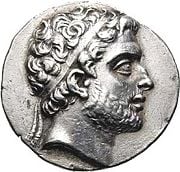
Traditionally, the Ancient Greek period was taken to begin with the date of the first Olympic Games in 776 B.C.E., but most historians now extend the term back to about 1000 B.C.E. The traditional date for the end of the Ancient Greek period is the death of Alexander the Great in 323 B.C.E. Ancient Greece is considered to be the foundational culture of Western Civilization.
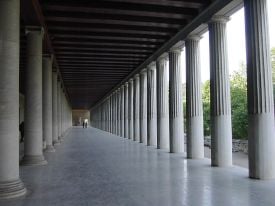
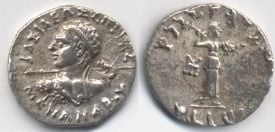
Obv: Greek legend, ΒΑΣΙΛΕΩΣ ΣΩΤΗΡΩΣ ΜΕΝΑΝΔΡΟΥ "[coin] of Saviour King Menander".
Rev: Kharosthi legend: MAHARAJA TRATASA MENADRASA "Saviour King Menander." Athena advancing right, with thunderbolt and shield. Taxila mint mark.
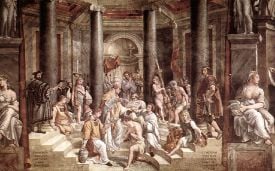

The basic unit of politics in Ancient Greece was the polis, sometimes translated as city-state. "Politics" literally means "the things of the polis." Each city was independent, at least in theory. Some cities might be subordinate to others (a colony traditionally deferred to its mother city), some might have had governments wholly dependent upon others (the Thirty Tyrants in Athens was imposed by Sparta following the Peloponnesian War), but the titularly supreme power in each city was located within that city. This meant that when Greece went to war (e.g., against the Persian Empire), it took the form of an alliance going to war. It also gave ample opportunity for wars within Greece between different cities.
Most of the Greek names known to modern readers flourished in this age. Among the poets, Homer, Hesiod, Pindar, Aeschylus, Sophocles, Euripides, Aristophanes, and Sappho were active. Famous politicians include Themistocles, Pericles, Lysander, Epaminondas, Alcibiades, Philip II of Macedon, and his son Alexander the Great. Plato wrote, as did Aristotle, Heraclitus of Ephesus, Parmenides, Democritus, Herodotus, Thucydides and Xenophon. Almost all of the mathematical knowledge formalized in Euclid's Elements at the beginning of the Hellenistic period was developed in this era.
Two major wars shaped the Ancient Greek world. The Persian Wars (500–448 B.C.E.) are recounted in Herodotus's Histories. Ionian Greek cities revolted from the Persian Empire and were supported by some of the mainland cities, eventually led by Athens. (The notable battles of this war include Marathon, Thermopylae, Salamis, and Plataea.)
Athens founded the Delian League in 477 B.C.E. to prosecute the war and to defend Greece from further Persian attack. Initially, each city in the league would contribute ships and soldiers to a common army, but in time Athens allowed (and then compelled) the smaller cities to contribute funds. Revolution from the league could be punished. Following military reversals against the Persians, the treasury was moved from Delos to Athens, further strengthening the latter's control over the league. The Delian League was eventually referred to pejoratively as the Athenian Empire.
In 458 B.C.E., while the Persian Wars were still ongoing, war broke out between the Delian League and the Peloponnesian League, comprising Sparta and its allies. After some inconclusive fighting, the two sides signed a peace in 447 B.C.E. That peace, it was stipulated, was to last 30 years: instead it held only until 431 B.C.E., with the onset of the Peloponnesian War. The war began over a dispute between Corcyra and Epidamnus, a minor enough city. Corinth intervened on the Epidamnian side. Fearful lest Corinth capture the Corcyran navy (second only to the Athenian in size), Athens intervened. The war continued through numerous stages until 404, when Athens surrendered to Sparta.
The war had left devastation in its wake. Discontent with the Spartan hegemony that followed (including the fact that it ceded Ionia and Cyprus to the Persian Empire at the conclusion of the Corinthian War (395–387 B.C.E.); induced the Thebans to attack. Their general, Epaminondas, crushed Sparta at the Battle of Leuctra in 371 B.C.E., inaugurating a period of Theban dominance in Greece. In 346 B.C.E., unable to prevail in its 10-year war with Phocis, Thebes called upon Philip II of Macedon (382-336) for aid.
Under Philip II, Macedon expanded into the territory of the Paionians, Thracians, and Illyrians. Macedon became more politically involved with the south-central city-states of Greece. Philip's son Alexander the Great (356-323) managed to briefly extend Macedonian power not only over the central Greek city-states, but also to the Persian empire, including Egypt and lands as far east as present-day Pakistan. The classical period conventionally ends at the death of Alexander in 323 B.C.E. and the fragmentation of his empire, divided among the Diadochi.
Hellenistic Greece

The Hellenistic period of Greek history begins with the death of Alexander the Great in 323 B.C.E. and ends with the annexation of the Greek peninsula and islands by Rome in 146 B.C.E. During the Hellenistic period the importance of "Greece proper" (that is, the territory of modern Greece) within the Greek-speaking world declined sharply.
Following Alexander's death, there was a struggle for the succession, known as the wars of the Diadochi (Greek for successors). The struggle ended in 281 B.C.E. with the establishment of four large territorial states.
- The Ptolemaic dynasty in Egypt based at Alexandria;
- The Seleucid dynasty in Syria and Mesopotamia based at Antioch;
- The Antigonid dynasty in Macedon and central Greece;
- The Attalid dynasty in Anatolia based at Pergamum.
His successors held on to the territory west of the Tigris for some time and controlled the eastern Mediterranean until the Roman Republic took control in the 2nd and 1st centuries B.C.E. Most of the east was eventually overrun by the Parthians, but Hellenistic culture held on in distant locations, like the Greco-Bactrian kingdom in Bactria, or the Indo-Greek kingdom in northern India, or the Cimmerian Bosporus. Hellenistic culture remained dominant in the Eastern part of the Roman Empire until its Christianization and transition to the Byzantine Empire.
Roman rule
Roman Greece is the period of Greek history (of Greece proper as opposed to the other centers of Hellenism in the Roman world) following the Roman victory over the Corinthians at the Battle of Corinth in 146 B.C.E. until the reestablishment of the city of Byzantium and the naming of the city by the Emperor Constantine as the capital of the Roman Empire (as Nova Roma, later Constantinople) in 330 C.E.
During the second and third centuries, Greece was divided into provinces including Achaea, Macedonia, Epirus, Thrace and Moesia. During the reign of Diocletian in the late third century, Moesia was organized as a diocese, and was ruled by Galerius. Under Constantine, Greece was part of the prefectures of Macedonia and Thrace. Theodosius I divided the prefecture of Macedonia into the provinces of Creta, Achaea, Thessalia, Epirus Vetus, Epirus Nova, and Macedonia. The Aegean islands formed the province of Insulae in the prefecture of Asiana.
Byzantine Empire


The Byzantine Empire is the term conventionally used to describe the Greek-speaking Roman Empire of the Middle Ages, centered on its capital of Constantinople. The empire is also known as the Eastern Roman Empire. Many consider Emperor Constantine I (reigned 306 C.E. –337 C.E.) to be the first "Byzantine Emperor." It was he who moved the imperial capital in 324 from Rome to Byzantium, refounded as Constantinople, or Nova Roma ("New Rome"). Some date the beginnings of the empire to the reign of Theodosius I (379–395) and Christianity's official supplanting of the pagan Roman religion, or following his death in 395, when the political division between East and West became permanent.
In the first period of the middle Byzantine era (610–867) the empire was attacked both by old enemies (Persians, Langobards, Avars and Slavs) as well as by new ones, appearing for the first time in history (Arabs, Bulgarians). These attacks became permanent settlements that transformed into new states, hostile to Byzantium. During this period the state was geographically reduced and economically damaged, since it lost wealth-producing regions. However, it obtained greater lingual, dogmatic and cultural homogeneity.
From the late eighth century, the empire began to recover from the devastating impact of successive invasions, and the reconquest of Greece began. Greeks from Sicily and Asia Minor were brought in as settlers. The Slavs were either driven out or assimilated and the Sclavinias were eliminated. By the middle of the ninth century, Greece was Greek again, and the cities began to recover due to improved security and the restoration of effective central control.
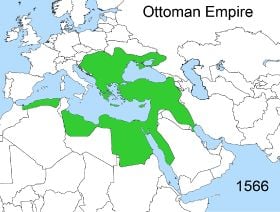
When the Byzantine Empire was rescued from a period of crisis by the resolute leadership of the three Komnenoi emperors Alexios (1048-1118), John (1087-1143) and Manuel (1118-1180) in the twelfth century, Greece prospered. This period was a time of significant growth in the rural economy, with rising population levels and extensive tracts of new agricultural land being brought into production. Many of the medieval towns, including Athens, Thessaloniki, Thebes and Corinth, experienced a period of rapid and sustained growth, starting in the eleventh century and continuing until the end of the twelfth century. The eleventh and twelfth centuries are said to be the Golden Age of Byzantine art in Greece. Many of the most important Byzantine churches in around Athens, for example, were built during these two centuries, and this reflects the growth of urbanization in Greece during this period.
The year 1204 marks the beginning of the late Byzantine period. Constantinople was lost for the Greek people for the first time, and the empire was conquered by Latin crusaders and would be replaced by a new Latin one, for 57 years. In addition, the period of Latin occupation decisively influenced the empire's internal development, as elements of feudality entered aspects of Byzantine life. In 1261, the Greek empire was divided between the former Greek Byzantine Comnenos dynasty members (Epirus) and Palaiologos dynasty (the last dynasty until the fall of Constantinople). After the gradual weakening of the structures of the Greek Byzantine state and the reduction of its land from Turkish invasions, came the fall of the Greek Byzantine Empire, at the hands of the Ottomans, in 1453, when the Byzantine period is considered to have ended.
Ottoman rule
Most of Greece was part of the Ottoman Empire from the fourteenth century until its declaration of independence in 1821. The Ottoman Turks first crossed into Europe in 1354. The Byzantine Empire, which had ruled most of the Greek-speaking world for over 1100 years, had been fatally weakened since the sacking of Constantinople by the Crusaders in 1204. Having defeated the Bulgarians in 1371 and the Serbs in 1389, the Ottomans advanced south into Greece proper, capturing Athens in 1458. The Greeks held out in the Peloponnese until 1460, and the Venetians and Genoese clung to some of the islands, but by 1500 most of the plains and islands of Greece were in Ottoman hands. The mountains of Greece were largely untouched, and were a refuge for Greeks to flee foreign rule. Cyprus fell in 1571, and the Venetians retained Crete until 1670. The Ionian Islands were only briefly ruled by the Ottomans (Kefalonia from 1479 to 1481 and from 1485 to 1500), and remained primarily under the rule of Venice.
When the Ottomans arrived, two Greek migrations occurred. The first migration entailed the Greek intelligentsia migrating to Western Europe and influencing the advent of the Renaissance. The second migration entailed Greeks leaving the plains of the Greek peninsula and resettling in the mountains. The Ottoman millet system, of separate courts under which minorities were allowed to rule themselves, contributed to the ethnic cohesion of Orthodox Greeks. The Greek Orthodox Church, an ethno-religious institution, helped the Greeks from all geographical areas of the peninsula to preserve their ethnic, cultural, and linguistic heritage during the years of Ottoman rule. The Greeks living in the plains during Ottoman occupation were either Christians who dealt with the burdens of foreign rule or Crypto-Christians (Greek Muslims who were secret practitioners of the Greek Orthodox faith). Many Greeks became Crypto-Christians in order to avoid heavy taxes and at the same time express their identity by maintaining their secret ties to the Greek Orthodox Church. However, Greeks who converted to Islam and were not Crypto-Christians were deemed Turks in the eyes of Orthodox Greeks, even if they didn't adopt Turkish language.
Greek War of Independence
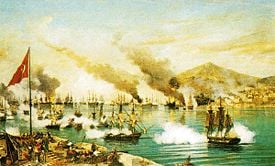
Greek nationalism surged in the latter part of the eighteenth century, aided by Russia, which incited the Greek Orthodox Christians to revolt. On March 25, 1821, (also the Greek Orthodox day of the Annunciation of the Theotokos), the Greeks rebelled and declared their independence. From 1821 to 1824, the Greeks fought alone. While the big European powers saw the war of Greek independence, with its accounts of Turkish atrocities, in a romantic light, scores of non-Greeks volunteered to fight for the cause, including Lord Byron.
Mahmud II, the Sultan of Turkey in 1824 sought help from Egyptian troops, and by 1826 controlled the southern peninsula. Because of the strategic importance of Greece, France, England or Russia agreed in 1827 to intervene militarily on behalf of the Greeks. In 1827, a Greek National Assembly approved a new republican constitution, and elected the Russian minister for foreign affairs, Ioannis Kapodistrias, himself a Greek, the first president of the Greek republic. Kapodístrias governed in a dictatorial fashion until he was assassinated in 1831. Civil war then broke out.
A Bavarian king

The European powers offered the throne to Otto (1815-1867), from Bavaria, who became the first modern king of Greece in 1832, under the protection of the Great Powers (the United Kingdom, France and the Russian Empire). Otto was aged 17 years on his accession. The Bavarian regents tried to set up a centralized bureaucracy, levied heavy taxes denied the Greeks a constitution.
1843 uprising
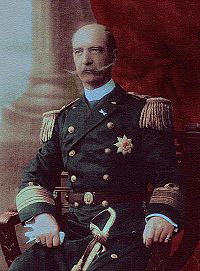
Greek resentment culminated in a bloodless revolution in 1843, which forced the king to grant a constitution and a representative assembly. Opposition to Otto increased in 1854, when he allowed the British and French occupation of Pireás to prevent a Graeco-Russian alliance during the Crimean War (1854-1856). In 1862, part of the Greek army revolted. He was eventually dethroned in 1863 and replaced by Prince Vilhelm (William) of Denmark, who took the name George I (1845-1913) and brought with him the Ionian Islands as a coronation gift from Britain. In 1877, Charilaos Trikoupis, a dominant figure of the Greek political scene who is attributed with the significant improvement of the country's infrastructure, curbed the power of the monarchy to interfere in the assembly by issuing the rule of vote of confidence to any potential prime minister.
Push for territory
Towards the end of the nineteenth century, Greece aimed to expand its territory. During the nineteenth and early twentieth centuries, in a series of wars with the Ottomans, Greece sought to enlarge its boundaries to include the ethnic Greek population of the Ottoman Empire. Thessaly was ceded by the Ottomans without a fight. As a result of the Balkan Wars of 1912-13 Epirus, southern Macedonia, Crete and the Aegean Islands were annexed into Greece—doubling in territory and population. In the years after, the struggle between the new king King Constantine I (1868-1923) and his charismatic prime minister Eleftherios Venizelos (1864-1936), over the country's foreign policy on the eve of World War I, dominated the country's political order, and divided the country into two bitterly hostile factions.
World War I
In World War I, Greece sided with the entente powers against Turkey and the other Central Powers. In the war's aftermath, the Great Powers awarded parts of Asia Minor to Greece, including the city of Smyrna (known as İzmir today) which had a Greek population of significant size. At that time, however, the Turkish nationalists led by Mustafa Kemal Atatürk, overthrew the Ottoman government, organized a military assault on the Greek troops, and defeated them. Immediately afterwards, over one million native Greeks of Turkey had to leave for Greece as a population exchange with hundreds of thousands of Muslims living in the Greek state.
Greco-Turkish war
In the aftermath of World War I, Greece fought a bloody and eventually unsuccessful war against Turkish nationalists led by Mustafa Kemal Atatürk. The Greco–Turkish War of 1919–1922, also called the War in Asia Minor, was a series of military events occurring during the partitioning of the Ottoman Empire after World War I between May 1919 and October 1922. The Greek campaign was launched because the western Allies, particularly British Prime Minister David Lloyd George, had promised Greece territorial gains at the expense of the Ottoman Empire. It ended with Greece giving up all territory gained during the war, returning to its pre-war borders, and engaging in a population exchange with the newly established state of Turkey under provisions in the Treaty of Lausanne. The collective failure of the military campaigns of Greece, and of the Turkish-Armenian and Franco-Turkish Wars against the Turkish revolutionaries, had forced the Allies to abandon the Treaty of Sèvres and negotiate at Lausanne a new treaty, recognizing the independence of the Turkish Republic and its sovereignty over Eastern Thrace and Anatolia. Instability and successive coup d'etats marked the following era, which was also colored by the massive task of incorporating the 1.5 million refugees from the Asia Minor into Greek society.
World War II

Despite the country's numerically small and ill-equipped armed forces, Greece made a decisive contribution to the Allied efforts in World War II. At the start of the war Greece sided with the Allies and refused to give in to Italian demands. Italy invaded Greece on October 28, 1940, but Greek troops repelled the invaders after a bitter struggle (see Greco-Italian War). This marked the first Allied victory in the war. Hitler then reluctantly stepped in, primarily to secure his strategic southern flank: troops from Germany, Bulgaria and Italy successfully invaded Greece, overcoming Greek, British, Australian and New Zealand units.
However, when the Germans attempted to seize Crete in a massive attack by paratroops—with the aim of reducing the threat of a counter-offensive by Allied forces in Egypt—the Cretan civilians and Allied Forces, offered fierce resistance. The Greek campaign delayed German military plans against Russia and it is argued that German invasion of the Soviet Union started on the 22nd of June 22 instead of the planned May 20.
During the years of Occupation of Greece by Nazi Germany, thousands of Greeks died in direct combat, in concentration camps or of starvation. The occupiers murdered the greater part of the Jewish community despite efforts by the Greek Orthodox Church and many Christian Greeks to shelter Jews. The economy was devastated. After liberation, Greece experienced an equally bitter civil war—between communist insurgents and the government forces (that encompassed republicans, liberals, fascists, royalists and conservatives) ; it lasted until 1949.
Civil war
The Greek Civil War was fought between 1946 and 1949, and represents the first example of a post-war communist insurgency. The civil war consisted on one side of the armed forces of the postwar non-Marxist Greek administrations, and on the other, communist-led forces, and key members of the former resistance organization (ELAS), the leadership of which was controlled by the Communist Party of Greece (KKE).
The first phase of the civil war occurred in 1942-1944. Marxist and non-Marxist resistance groups fought each other in a fratricidal conflict to establish the leadership of the Greek resistance movement. In the second phase (1944) the communists, in military control of most of Greece, confronted the returning Greek government in exile, which had been formed under Western Allied auspices in Cairo and originally included six Communist Party-affiliated ministers. In the third phase (1946-1949), guerrilla forces controlled by Communist Party fought against the internationally recognized Greek Government which was formed after elections boycotted by the Communist Party. Although the involvement of the Communist Party in the uprisings was universally known, the party remained legal until 1948, continuing to coordinate attacks from its Athens offices until proscription.
The civil war left Greece with a legacy of political polarization; as a result, Greece also entered into alliance with the United States and joined the North Atlantic Treaty Organization in 1952, while relationships with its Soviet-allied northern neighbors became strained.
Post-war recovery
The next 20 years were characterized by a significant economic growth, propelled in part by the Marshall Plan. In 1965, a period of political turbulence and the rise of the center-left led to a coup d’etat on April 21, 1967, by the Regime of the Colonels. In November 1973 the Athens Polytechnic Uprising sent shock waves across the regime, and a counter-coup established Brigadier Dimitrios Ioannides as dictator. On July 20, 1974, as Turkey invaded the island of Cyprus, using a junta-sponsored coup d'etat in the island as a pretext, the regime collapsed.
Democracy restored
Ex-Premier Constantine Karamanlis was invited back from Paris where he had lived in self-exile since 1963, marking the beginning of the Metapolitefsi era. A 1975 democratic republican constitution was activated and the monarchy abolished by a referendum held that same year. On January 1, 1981, Greece entered the European Union, and has experienced an unprecedented period of prosperity ever since. Meanwhile, Andreas Papandreou had also founded the Panhellenic Socialist Party, or PASOK, in response to Constantine Karamanlis New Democracy party, and the two groupings have dominated Greek political affairs in the ensuing decades. Under Kostas Simitis's stewardship, Greece completed its move to the Euro zone in 2001 and the country successfully organized the 2004 Olympic Games in Athens. Greece has belonged to the OECD since 1961, the WEU since 1995, and ESA since 2005.
Government and politics


The 1975 constitution, which describes Greece as a "presidential parliamentary republic," includes extensive specific guarantees of civil liberties and vests the powers of the head of state in a president elected by parliament. The Greek governmental structure is similar to that found in many Western democracies, and has been described as a compromise between the French and German models. The prime minister and cabinet play the central role in the political process, while the president performs some executive and legislative functions in addition to ceremonial duties.
The head of state is the President of the Republic, who is elected by the Parliament for a five-year term, and is eligible for a second term. The president appoints the leader of the party securing plurality of vote in a legislative election to become prime minister and form a government.
The president appoints leader of the party securing most votes in a legislative election to become prime minister and form a government. The Prime Minister exercises vast political power, and the amendment of 1986 further strengthened his position to the detriment of the President of the Republic. The Cabinet of Greece includes the heads of all executive ministries, appointed by the president on the recommendation of the prime minister.
The Greek Parliament has 300 members, elected for a four-year term by a system of reinforced proportional representation in 48 multi-seat constituencies, eight single-seat constituencies and a single nationwide list. A total 288 of the 300 seats are determined by constituency voting, and voters may select the candidate or candidates of their choice by marking their name on the party ballot. The remaining 12 seats are filled from nationwide party lists. Any single party must receive at least a three percent nationwide vote tally to gain representation. Suffrage is universal and compulsory to those aged 18 years and over.
The Judiciary is independent of the executive and the legislature and comprises three Supreme Courts: the Court of Cassation, the Council of State and the Court of Auditors (Ελεγκτικό Συνέδριο). The Judiciary system is also composed of civil courts, which judge civil and penal cases and administrative courts, which judge administrative cases, namely disputes between the citizens and the State.
Administrative divisions

Greece is divided in 13 peripheries, further divided into 51 prefectures, the "Nomoi." The prefectures are each headed by a prefect, who is elected by direct popular vote. The 13 regional administrative districts (peripheries), each including a number of prefectures are headed by a regional governor, appointed by the Minister of the Interior. In northern Greece and in greater Athens, three areas have an additional administrative position between the nomarch and peripheriarch. This official, known as the Chair of the prefectural local authorities or "superprefect," is elected by direct popular vote together with the nomarchs she or he supervises. Although municipalities and villages have elected officials, they depend on the central government budget for their financial needs, and are subject to central government controls. This also leads to extremely low municipal taxes (usually around 0.2 percent or less). The 13 peripheries are: Attica 1, Central Greece 2, Central Macedonia 3, Crete 4, East Macedonia and Thrace 5, Epirus 6, Ionian Islands 7, North Aegean 8, Peloponnese 9, South Aegean 10, Thessaly 11, West Greece 12, and West Macedonia 13.
Greece also includes one autonomous region, the Monastic Community of the Holy Mountain, Mount Athos.
The Hellenic Armed Forces consists of army, air force and navy. The army had 109,266 personnel on active duty in 2007, and the air force had 33,000 active troops. Greece has an extensive navy, with Hydra class and more Standard class frigates. Greece was the first Mediterranean country to receive guided missile destroyers, which have since been decommissioned. Military service is compulsory for males in the year they turn 18—with a service obligation of 12 months for the army and air force, and 15 months for the navy.
Economy

Greece is a developed country operating a capitalist economy. Its principal economic activities include tourism and shipping industries, banking and finance, manufacturing and construction and telecommunications. The country serves as the regional business hub for many of the world's largest multinational companies.
The service industry makes up the largest, most vital and fastest-growing sector of the Greek economy, followed by industry and agriculture . The tourism industry is a major source of foreign exchange earnings and revenue. The Greek banking and finance sector is also an important source of revenue and employment and Greek banks have invested heavily in the Balkan region.
High-technology equipment production, especially for telecommunications, is also a fast-growing sector. Other important areas include textiles, building materials, machinery, transport equipment, and electrical appliances. Construction and agriculture are yet two other significant sectors of the Greek economic activity.

The shipping industry is a key element of Greek economic activity. Given that Greece is a peninsula, shipping in ancient times was the natural way for Greeks to reach their neighboring people, trade with them and expand by establishing colonies. Today, shipping is one of the country's most important industries.
Because of its strategic location, qualified workforce and political and economic stability, many multinational companies, such as Ericsson, Siemens, SAP, Motorola, Coca-Cola have their regional R&D Headquarters in Greece.
Greece was a founding member of the Organisation for Economic Co-operation and Development (OECD) and the Organization of the Black Sea Economic Cooperation (BSEC). In 1979 the accession of the country in the European Communities and the single market was signed, and the process was completed in 1982. Greece was accepted into the Economic and Monetary Union of the European Union on June 19, 2000, and in January 2001 adopted the Euro as its currency, replacing the Greek drachma. Greece is also a member of the International Monetary Fund and the World Trade Organization.
Greece has been a member of the European Space Agency (ESA) since 2005. Cooperation between ESA and the Hellenic National Space Committee began in the early 1990s. In 1994, Greece and ESA signed their first cooperation agreement. Having formally applied for full membership in 2003, Greece became ESA's sixteenth member on March 16, 2005. As a member of the ESA, Greece participates in the agency's telecommunication and technology activities, and the Global Monitoring for Environment and Security Initiative.
Demographics



Ethnicity
Greeks make up the large majority of the population. The Greeks are a nation and ethnic group who have populated Greece and the area of the Aegean Sea for over 3500 years. The Mycenaean proto-Greeks were probably the first historical people to arrive in the area now referred to as 'Greece' (the southern tip of the Balkan peninsula) in the 16th century B.C.E. and the first that can be considered "Greek" as an ethnic identity. The Greek genetic Tree was constructed revealed homogeneity with Europeans.
The only minority in Greece which receives special treatment is the Muslim minority in Thrace, which amounts to approximately 0.95 percent of the total population. Its members are predominantly of Turkish, Pomak and Roma ethnic origins. Other recognized ethnic minorities include approximately 35,000 Armenians and 5500 Jews.
Religion
The constitution of Greece recognizes the Greek Orthodox faith as the "prevailing" religion of the country, while guaranteeing freedom of religious belief for all. The Greek Government does not keep statistics on religious groups and censuses do not ask for religious affiliation. The majority of Greek citizens (98 percent) identify themselves as Greek Orthodox, and most of them celebrate at least the main religious feasts, especially Pascha (Greek Orthodox Easter).
During the centuries of Ottoman domination, besides its spiritual mandate, the Orthodox Church, based in Constantinople (present-day Istanbul), also functioned as an official representative of the Christian population of the empire. The Church is often credited with the preservation of Greek language, values, and national identity during Ottoman times. The Church was also an important rallying point in the war for independence, although the Church in Constantinople initially condemned the breakout of armed struggle against the empire. The Greek Orthodox Church was established shortly after the formation of a Greek national state. Its authority to this day extends only to the areas included in the embryonic Greek state of 1833.
There is a Muslim minority, concentrated in Thrace, and officially protected by the treaty of Lausanne. Besides Pomaks (Muslim Slavic Speakers) and Roma, it consists mainly of ethnic Turks, who speak Turkish and receive instruction in Turkish at special government-funded schools. There are also a number of Jews in Greece, most of whom live in Thessaloniki. There are also some Greeks who adhere to a reconstruction of the ancient Greek Religion.
Language

Greek is the official language and is spoken by 99 percent of the population. It is an Indo-European language that has been used in the region for nearly 4000 years, although it has changed considerably. The ordinary spoken language is known as demotic and the formal version, known as katharevousa, was developed in the eighteenth century. Katharevousa initially spread quickly among political leaders and the intelligentsia, although most turned back to demotic Greek by the twentieth century. Church services are conducted in koine, a form of ancient Greek in which the New Testament is written. There are also regional dialects. English and French are also widely used. The rise of internet-based communication services as well as cell phones have caused a distinctive form of Greek written partially, and sometimes fully in Latin characters has emerged; this is known as Greeklish, a form that has spread across the Greek diaspora and even to the two nations with majority Greek speaking populations, Cyprus and Greece.
Marriage and the family
The family is the basic unit of support and identity in Greek society, and nearly all people marry. Arranged marriages were once common but have declined. Marriages are monogamous, and the average age at marriage is the late 20s for women and the mid-30s for men. The divorce rate is among the lowest in Europe, although it has risen steadily since the 1980s. Until 1982, all marriages occurred in churches, but civil marriages have been legal since that time. Nuclear family households are the most common, though various forms of extended kin arrangements also exist. It is common for elderly parents to join the household of one of their adult children. Regarding inheritance, sons and daughters receive roughly equivalent shares of their parents' wealth. Women received full voting rights in 1956, and the Family Law of 1983 established legal gender equality in family relationships and decision making.
Education
Nursery schools and kindergartens are popular but not compulsory. Children start primary school aged six and remain there for six years. Some primary schools are "all-day," offering an extended timetable and enriched syllabus. Attendance at gymnasia starts at age 12 and lasts for three years. Greece's post-compulsory secondary education consists of two school types: unified upper secondary schools and technical-vocational schools, as well as vocational training institutes.
Public higher education is divided into universities, "highest educational institutions" and "highest technological educational institutions." Students are admitted to these institutes according to their performance at national level examinations taking place after completion of the third grade of Lykeio. Additionally, students over 22 years old may be admitted to the Hellenic Open University through a form of lottery.
The Greek education system also provides special kindergartens, primary and secondary schools for people with special needs or difficulties in learning. Specialist gymnasium and high schools offering musical, theological and physical education also exist. Regarding literacy, 97.5 percent of the total population over the age of 15 could read and write in 2003.
Class
The modern Greek state, the departure of the Ottomans, and the dismantling of agricultural estates, has brought mobility to the class system. Social status results from a combination of wealth, education, occupation, and what is known as philotimo, or one's sense of social responsibility, esteem, and attention to proper behavior. The trappings of wealth convey a high position, as do urban residence, the use of katharevousa, fluent English and French, and the adoption of Western styles.
Culture
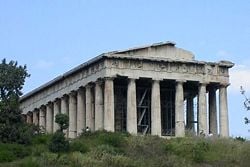
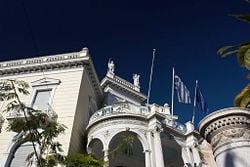
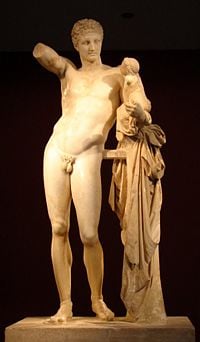
Architecture
Remains of ancient Greek architecture still survive or are well documented today alongside more modern examples. It emphasized a Grecian cross layout, the Byzantine capitol style of column (a mixture of Ionic and Corinthian capitols) and a central dome surrounded by several smaller domes. Greece also experienced something of a Neo-Byzantine revival following the Greek Revolution, and quite unsurprisingly, also experienced a growth in Neo-Classical Architecture in the years following the revolution. This came into a contact and interaction with traditional Byzantine villa architecture to produce a form specific to modern Greece
Modern Greek architecture has followed the international architecture trends. Like other modern capitals, Athens also has its fair share of Neo-classic, Modernist and Postmodernist architecture. Important Greek and international architects have designed many buildings of Athens such as Dimitris Pikionis, Stamatis Kleanthis, Ernst Ziller, Theophil Freiherr von Hansen, Patroklos Karantinos, Walter Gropius, Eero Saarinen and Mario Botta. Several new buildings were also constructed by Santiago Calatrava for the Athens Olympics of 2004 while Bernard Tschumi has designed the New Acropolis Museum.
Art
Surviving ancient Greek paintings are very rare. Greek painters worked mainly on wooden panels, and their finest works were admired for hundreds of years after their creation. However, these paintings rapidly disappeared after the fourth century C.E. when they were no longer adequately protected. Rare surviving examples have been found in the tombs of the kings of Macedon at Vergina, at Lefcadia also in ancient Macedon, as well as Kazanlak in ancient Thrace.
Surviving examples of the ancient Greek sculpture are more common, particularly the works of the Greek master sculptors, such as Phidias and Praxiteles. These artists and their followers were frequently emulated by the Romans. However, the Christians of the fourth and fifth centuries viewed the destruction of pagan idols as an act of piety. Many ancient marble sculptures were burned to form lime in the Middle Ages, and most bronze statues were melted down for their metal. The marble statues that escaped destruction were spared as they were either buried and forgotten, or in the case of bronzes, lost at sea.
In the Byzantine period, religious art was the dominant theme, with highly-decorated mosaics and icons adorning religious buildings. The Renaissance artist, El Greco (Domenikos Theotocopoulos), responded to Byzantine and sixteenth century Mannerist art, producing sculpture and paintings with a liberated form, light and color that inspired twentieth century artists such as Pablo Picasso and Jackson Pollock.
Moreover, an important and often pioneering role was played by artists from Ionian islands in the eighteenth and the beginning of the nineteenth century, who exploited developments of the Italian Renaissance and baroque schools. As efforts persisted with new directions and objectives, Greek artists emerging in the world during the first decades of the nineteenth century reconnected Greek art with its ancient tradition, as well as with the quests of the European schools, especially those of the Munich School, with defining examples of the Greek contemporary art of the period including the work of Theodoros Vryzakis and Nikiphoros Lytras. The British-Greek Marie Spartali became the pre-eminent female artist of the Pre-Raphaelite era.
Clothing

The costumes of Greece are a rich part of a multi-layered cultural history. Some characteristics of Greek folk costumes can be traced back to elements in ancient and Byzantine costume; in fact, many of the elements of liturgical clothing worn by Greek Orthodox priests also a bear relation to modern Greek folk costume, and have their origin in the clothing of the Byzantine Empire. The costumes of the mainland and of the islands show differences, but also maintain the standard Foustanella as their basic clothing part. Furthermore, the costumes of each area tend to have several elements in common. While common elements across the country are demonstrable in materials, construction, parts, and designs, smaller regions also share certain distinct regional characteristics. For example, costumes can be identified as being from Epiros, or Mesogeia, or Makedonia; however, the identification of costumes can be also be narrowed to smaller areas within these broader geographical and cultural areas. A costume's village can be identified by individual features such as the shape of a costume part, or the colors or the embroidery designs used. This is also true with respect to the various costumes worn by Greeks of the islands, and beyond, across the regions of Greece.
Cuisine

Greek cuisine is often cited as an example of the healthy Mediterranean diet. The cuisine of Greece has influences from Italian, Balkan and Middle Eastern cuisine. Greek cuisine incorporates fresh ingredients into a variety of local dishes such as moussaka, stifado and spanakopita. Throughout Greece people often enjoy eating from small dishes such as meze with various dips such as tzatziki, grilled octopus and small fish, feta cheese, dolmades (rice, currants and pine kernels wrapped in vine leaves), various pulses, olives and cheese. Olive oil is added to almost every dish. Greeks enjoy sweet desserts such as galaktoboureko, and alcoholic drinks such as ouzo, metaxa and a variety of wines including retsina. Greek cuisine differs widely from different parts of the mainland and between islands. Cyprus in particular, has many delicacies that are native to it alone, such as grilled halloumi cheese and louvi.
Dance
Ancient Greeks believed that dancing was invented by the gods and therefore associated it with religious ceremony. They believed that the gods offered this gift to select mortals only, who in turn taught dancing to their fellow-men. Popular dances of this period included the Syrtos, Geranos, Mantilia, Saximos, Pyrichios, and Kordakas. Some of these dances have their origins in the ancient period and are still enacted in some form today.
Greece is one of the few places in Europe where the day-to-day role of folk dance is sustained. Rather than functioning as a museum piece preserved only for performances and special events, it is a vivid expression of everyday life. Occasions for dance are usually weddings, family celebrations, and paneyeria (Patron Saints' name days). Dance has its place in ceremonial customs that are still preserved in Greek villages, such as dancing the bride during a wedding and dancing the trousseau of the bride during the wedding preparations. The carnival and Easter offer more opportunities for family gatherings and dancing. Greek taverns providing live entertainment often include folk dances in their program.
Kalamatianos and Tsamikos are considered panhellenic dances and are danced all over the world in diaspora communities. Others have also crossed boundaries and are known beyond the regions where they originated; these include the Karagouna from Thessaly, the Pentozalis from Crete, the Zonaradikos from Thrace, the Tik from Pontos, and the Balos from the Aegean Islands.
The avant-garde choreographer, director and dancer Dimitris Papaioannou was responsible for the critically successful opening ceremony of the 2004 Olympic Games, with a conception that reflected the classical influences on modern and experimental Greek dance forms.
Literature
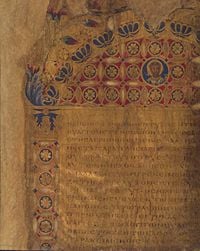
The first recorded works in the western literary tradition are the epic poems of Homer and Hesiod. Early Greek lyric poetry, as represented by poets such as Sappho and Pindar, was responsible for defining the lyric genre as it is understood today in western literature. Aesop wrote his Fables in the sixth century B.C.E. The many elements of a millennia-old tradition are reflected in Modern Greek literature, including the works of the Nobel laureates Odysseus Elytis and George Seferis. Moving into the twentieth century, the modern Greek literary tradition spans the work of Constantine P. Cavafy, considered a key figure of twentieth century poetry, Giorgos Seferis (whose works and poems aimed to fuse the literature of Ancient and Modern Greece) and Odysseas Elytis, both of whom won the Nobel Prize for Literature. Nikos Kazantzakis is also considered a dominant figure, with works such as The Last Temptation of Christ and The Greek Passion receiving international recognition. Vassilis Vassilikos is widely translated.
Music
The history of music in Greece begins with the music of ancient Greece, largely structured on the lyre and other supporting string instruments of the era. The well-known structural legacies of the Pythagorean scale, and the related mathematical developments it upheld helped to define western classical music. A range of domestically and internationally known composers and performers across the musical spectrum have found success in modern Greece, while traditional Greek music is noted as a mixture of influences from indigenous culture with those of west and east. Turkish and Ottoman elements can be heard in the traditional songs, dhimotiká, as well as the modern bluesy rembétika music. The best-known Greek musical instrument is the bouzouki. "Bouzouki" is a descriptive Turkish name, but the instrument itself is in fact of Greek rather than Turkish origin. It derives from the ancient Greek lute known as the pandoura, a kind of guitar, clearly visible in ancient statues, especially female figurines of the "Tanagraies" playing cord instruments.
Famous Greek musicians include Iannis Xenakis, a composer, architect and theorist. Maria Callas, Mikis Theodorakis, Dimitris Mitropoulos, Manos Hadjidakis, and Vangelis, alongside Nikos Skalkottas, Demis Roussos, Nana Mouskouri, Rotting Christ and Anna Vissi.
Philosophy
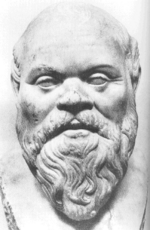
Herodotus and Thucydides are often attributed with developing the modern study of history into a field worthy of philosophical, literary, and scientific pursuit. Polybius first introduced into study the concept of military history. Philosophy entered literature in the dialogues of Plato, while his pupil Aristotle, in his work the Poetics, formulated the first set criteria for literary criticism. Both these literary figures, in the context of the broader contributions of Greek philosophy in the Classical and Hellenistic eras, were to give rise to idea of Political Science, the study of political evolution and the critique of governmental systems.
Science and technology
Thales, Anaximander and Democritus were among those contributing significantly to the development of science by means of observation, thought, and development of a theory without relying on supernatural force. Greek developments of mathematics continued well up until the decline of the Byzantine Empire.
In medicine, doctors still refer to the Hippocratic Oath, instituted by Hippocrates, regarded as foremost in laying the foundations of medicine as a science. Galen built on Hippocrates' theory of the four humors, and his writings became the foundation of medicine in Europe and the Middle East for centuries. The physicians Herophilos and Paulus Aegineta were pioneers in the study of anatomy, while Pedanius Dioscorides wrote an extensive treatise on the practice of pharmacology.
Greeks continue to contribute to science and technology in the modern world. John Argyris, a Greek mathematician and engineer, is responsible for the invention of finite element analysis and the direct stiffness method, relative to physics. Mathematician Constantin Carathéodory worked in the fields of real analysis, the calculus of variations, and measure theory in the early twentieth century, and went on to assist Albert Einstein in the mathematical part of his theory of relativity. Biologist Fotis Kafatos pioneers in the field of molecular cloning and genomics; Dimitris Nanopoulos is a noted theoretical physicist, having made significant contributions to the fields of particle physics and cosmology. In medicine, Georgios Papanikolaou contributed heavily to the development of cancer screening with his Pap smear. The Greek car designer Alec Issigonis created the iconic Mini automobile, while the computer scientist Michael Dertouzos was among the pioneers of the internet. Nicolas Negroponte chairman of the Massachusetts Institute of Technology Media Lab is one of the founders of the program One Laptop Per Child, a non-profit organization aiming to extend Internet access in developing countries.
Theatre
Classical Greece is also judged the birthplace of theatre. Aeschylus introduced the ideas of dialogue and interacting characters to playwriting and in doing so, he effectively invented "drama": his Oresteia trilogy of plays is judged his crowning achievement. Other refiners of playwriting were Sophocles and Euripides. Aristophanes, a comic playwright, defined and shaped the idea of comedy as a theatrical form.
Notes
- ↑ 2011 Population-Housing Census Hellenic Statistical Authority. Retrieved April 22, 2020.
- ↑ 2.0 2.1 2.2 2.3 Greece Report for Selected Countries and Subjects, International Monetery Fund.
- ↑ GINI index (World Bank estimate) The World Bank. Retrieved April 22, 2020.
References
ISBN links support NWE through referral fees
- Clogg, Richard. A Concise history of Greece. Cambridge concise histories. Cambridge [England]: Cambridge University Press, 1992. ISBN 978-0521378307
- Curtis, Glenn E. Greece, a country study. Area handbook series. Washington, DC: The Division, 1995. ISBN 978-0844408569
- Green, Peter. A concise history of Ancient Greece to the close of the classical era. London: Thames and Hudson, 1973. ISBN 978-0500450147
- Danforth, Loring M. The Macedonian conflict ethnic nationalism in a transnational world. Princeton, NJ: Princeton University Press, 1995. ISBN 978-0691043579
- Gourgouris, Stathis. Dream nation enlightenment, colonization, and the institution of modern Greece. Stanford, CA: Stanford University Press, 1996. ISBN 978-0804727259
External links
All links retrieved July 14, 2017.
- Culture of Greece Countries and Their Cultures.
- Greece BBC Country Profiles.
- Greece U.S. Department of State.
- Greece economist.com.
- Hellenic History
Credits
New World Encyclopedia writers and editors rewrote and completed the Wikipedia article in accordance with New World Encyclopedia standards. This article abides by terms of the Creative Commons CC-by-sa 3.0 License (CC-by-sa), which may be used and disseminated with proper attribution. Credit is due under the terms of this license that can reference both the New World Encyclopedia contributors and the selfless volunteer contributors of the Wikimedia Foundation. To cite this article click here for a list of acceptable citing formats.The history of earlier contributions by wikipedians is accessible to researchers here:
- Greece history
- Geography_of_Greece history
- History_of_Greece history
- Byzantine_Empire history
- Ottoman_Greece history
- Greek_Civil_War history
- Politics_of_Greece history
- Demographics_of_Greece history
- Greeks history
- Culture_of_Greece history
The history of this article since it was imported to New World Encyclopedia:
- History of "Greece"
Note: Some restrictions may apply to use of individual images which are separately licensed.
↧ Download as ZWI file | Last modified: 02/03/2023 20:22:51 | 212 views
☰ Source: https://www.newworldencyclopedia.org/entry/Greece | License: CC BY-SA 3.0
 ZWI signed:
ZWI signed:

 KSF
KSF